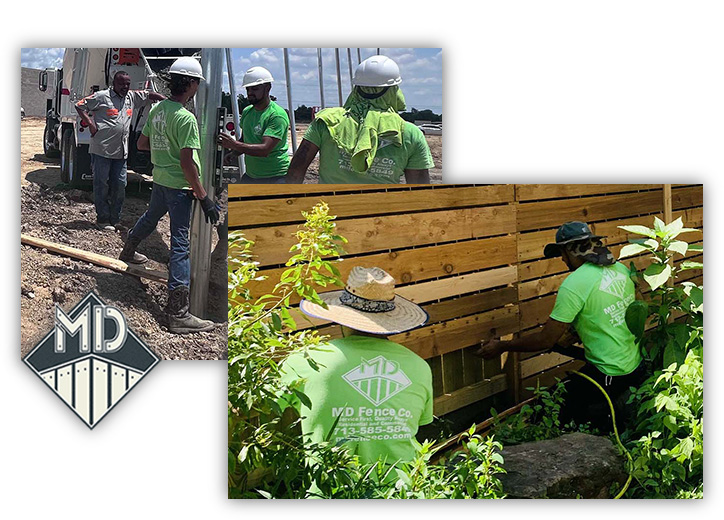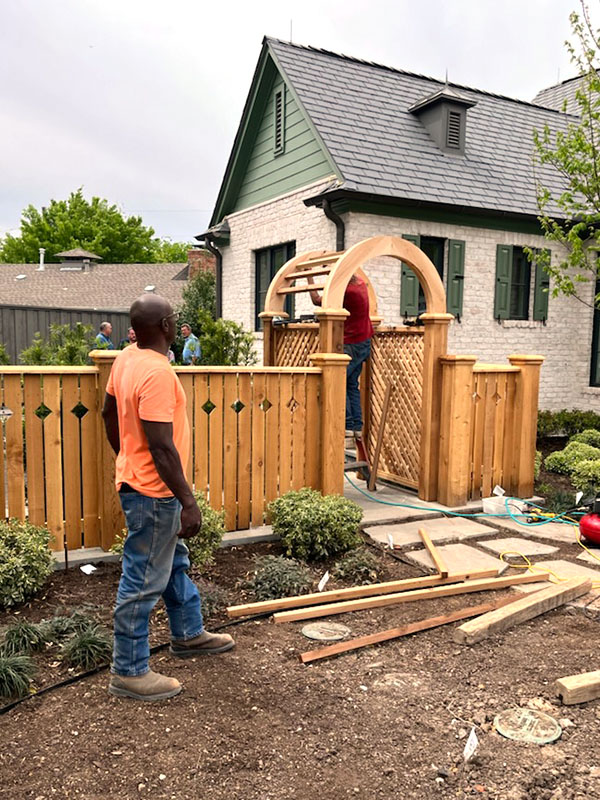How to Recognize Typical Problems That Need Immediate Fence Fixing
It is vital to find problems prior to they become larger issues when it comes to keeping your fencing. Routinely inspecting for signs of decomposing timber, leaning panels, or corrosion can save you money and time in the future. You may not understand how weather and parasites can endanger your fencing's integrity. Let's discover the usual indicators that show your fencing requires prompt interest, so you can keep your residential property secure and looking its best.
Indicators of Rotting Wood in Wooden Fences
Have you noticed your wood fencing looking a little bit even worse for wear? It might be time to inspect for indicators of deteriorating wood if so. Initially, analyze the base of the posts and panels for soft spots. If you continue the wood and it feels mushy or falls apart, that's a clear indication of rot. Next, seek discoloration or dark spots on the timber-- these often signal wetness damage. Pay focus to any type of peeling paint or finish, as this can subject the timber to further degeneration. Furthermore, a pungent, musty odor can suggest fungal development. Do not fail to remember to check links and joints; if they hang or falling apart, the timber underneath is likely jeopardized. By capturing these signs early, you can stop more considerable damage and maintain your fencing standing solid. Normal maintenance is crucial to expanding the life of your wood fence.
Leaning or Tilting Fencing Panels
If you have actually observed your fencing panels tilting or leaning, it's essential to understand what triggered it. This issue may show underlying architectural damage that needs your attention. Allow's explore the common causes and the fixing options available to get your fence back fit.

Reasons For Leaning Panels
It's usually an indicator of underlying issues that need addressing when you notice your fence panels leaning or turning. One typical reason is inadequate drainage; too much water can deteriorate the dirt around the fencing blog posts, damaging their support. An additional offender can be strong winds or tornados that press versus the panels, especially if they're not appropriately anchored. Additionally, the natural settling of soil over time can cause messages to shift, bring about a tilt. Bugs, like termites, can endanger the honesty of wooden panels, causing them to lean. Ultimately, poor setup techniques might lead to panels not being firmly established, leaving them prone to leaning under stress. Address these concerns promptly to keep your fencing's honesty.
Indications of Structural Damages
Observing leaning or turning fence panels can be startling, as these problems commonly suggest architectural damages that needs instant focus. When your fencing begins to lean, it may signify that the posts are changing or that the soil around them has worn down. Pay very close attention to gaps between posts or panels, as these can also suggest instability. deck builder. Furthermore, look for fractures or splintering in the timber, which can weaken the overall structure. It can jeopardize the stability of the fencing if you discover corrosion or rust on steel elements. Keep in mind, overlooking these indicators can bring about extra severe damages down the line, so it's vital to assess the scenario immediately and do something about it prior to it gets worse
Repair Work Options Available
Rust and Corrosion in Steel Fences
If you have a steel fence, you may observe rust and rust slipping in gradually, particularly if it's subjected to wetness. These issues not just affect the appearance of your fencing but can additionally jeopardize its structural stability. To identify corrosion, try to find reddish-brown areas or spots, which indicate the metal is oxidizing. Deterioration can spread out swiftly if left untreated, compromising the fencing and leading to costly repairs.To take on rust and rust, you must clean the impacted locations with a wire brush and use a rust-inhibiting primer. As soon as the guide dries, think about painting the fence with a weather-resistant paint to secure it additionally. Routine upkeep, such as examining for indicators of rust and retouching paint as required, will aid extend your fencing's lifespan. Attending to these issues promptly ensures your steel fencing stays strong and aesthetically appealing for many years ahead.
Cracks and Divides in Plastic Fence

Root Causes Of Plastic Damage
Plastic fencing is popular for its durability, yet it can still struggle with fractures and splits as a result of numerous elements. One significant reason is extreme temperature changes. When vinyl broadens in the heat and contracts in the cold, it can deteriorate the material gradually. Furthermore, direct exposure to severe sunlight can cause UV degradation, making the vinyl weak. Physical impacts, like hefty branches or unexpected crashes, can also produce splits. Poor setup or making use of low-quality materials can worsen these concerns. Age plays a role; older vinyl secure fencing is much more vulnerable to damage. Routine inspections can aid you determine these factors prior to they result in substantial issues. Take positive measures to ensure your fencing remains strong and intact.
Repairing Cracks Successfully
Cracks and splits in your vinyl fencing can be worrying, resolving them promptly can prevent further damage and keep the fencing's look. Examine the dimension of the crack. For little splits, a dig this vinyl repair service package typically includes adhesive that can bond the sides, supplying a smooth repair. Clean the location completely prior to applying the adhesive, guaranteeing it sticks properly. For bigger splits, you may require to utilize a vinyl patch. Cut the patch to size, apply glue around the edges, and press it securely onto the split. Allow it to heal according to the producer's guidelines. Regular upkeep and fast repair work can extend your fencing's lifespan, maintaining it looking excellent for many years to come.
Loosened or Missing Out On Fencing Articles
Loosened or missing fencing articles can weaken the stability of your entire fencing structure. If you observe any blog posts tottering or leaning, it's important to attend to the issue quickly. Look for any indicators of movement, as this can cause more damage in time. You can conveniently evaluate the issue by offering each post a gentle shake-- if it feels unsteady, it's time to take action.For missing out on messages, you'll require to change them asap to keep your fencing's integrity. When you install new blog posts, make certain they're securely anchored in the ground with concrete or crushed rock for included stability. If an article hangs, tighten it by adding extra assistance or driving it deeper into the ground.Ignoring these problems can cause bigger issues, like voids in your fencing or also full collapse. So, keep an eye on your messages and stay proactive regarding fixings!
Damage From Weather and Natural Environment
Weather and natural environments can wreak mayhem on your fencing, causing different forms of damages that require prompt focus. Hefty rainfall can trigger wood to rot, making it unpredictable and weak. Snow accumulation could bend or break panels, while strong winds can root out fence posts or create sections to lean.If you notice fractures or splintering in wood fencings, it's an indication of drying out as a result of intense sun exposure. Metal fences can rust if protective finishes use off, particularly in coastal or humid areas.Inspect your fence frequently after tornados or severe weather condition to capture any type of damage early. Attending to these issues swiftly can save you from pricey repair services down the line. Do not wait until a small trouble develops into a significant one; stay proactive and keep your surround leading form to preserve both capability and curb appeal.
Bug Infestation and Termite Damage
It's crucial to act quickly to avoid additional damage when you see indicators of pest infestation or termite damage. Seek get redirected here mud tubes along your fencing or hollow-sounding timber, as these indicate termites go to job. You could additionally see tiny holes or frass, which is termite droppings appearing like sawdust. If you detect any one of these indicators, it's time to examine the damage.Don' t wait until it's far too late; insects can endanger your fencing's honesty. Evaluate the surrounding location for ants or beetles, as they may be adding to the issue. If you believe an invasion, take into consideration getting in touch with an insect control professional to verify and deal with the issue.Repairing or changing afflicted areas of your fence quickly not just recovers its toughness yet likewise avoids bugs from spreading out additionally. Remain attentive to maintain your home pest-free and safe.
Frequently Asked Concerns
How Typically Should I Inspect My Fencing for Damage?
You should examine your fencing at the very least twice a year, preferably throughout spring and loss. Routine checks assist you detect damage early, conserving you money and time on repairs while maintaining your property's look and protection.
Can I Fix a Fence Myself or Hire an Expert?
You can certainly repair a fencing yourself if you have the right tools and abilities. However, working with a professional warranties quality job and conserves you time, especially for intricate repair services or extensive damage.
What Tools Are Required for Fundamental Fence Repairs?
For fundamental fencing fixings, you'll need tools like a hammer, screwdriver, pliers, a saw, a level, and determining tape. deck builder. Depending upon the fixing, you could also require nails, screws, or substitute boards
Just How Much Does Fencing Repair Normally Cost?
Fence repair work expenses vary commonly, yet you can anticipate to pay in between $200 and $1,500 relying on materials, labor, and extent of damage. It's clever to obtain numerous quotes for the very best offer.
When Is the most effective Time of Year for Fencing Repair Works?
The most effective time for fence repair work is throughout moderate weather condition, normally in springtime or very early fall. You'll avoid severe temperatures, making it much easier to function and making sure the materials established properly for lasting longevity (deck builder). Noticing tilting or leaning fencing panels can be disconcerting, as these problems frequently indicate structural damages that needs immediate interest. Loose or absent fencing blog posts can threaten the stability of your whole fencing framework. Snow top article buildup might flex or break panels, while strong winds can uproot fencing messages or cause sections to lean.If you see splits or splintering in wooden fencings, it's an indicator of drying out due to extreme sun direct exposure. Metal fencings can rust if safety layers use off, specifically in moist or seaside areas.Inspect your fence frequently after tornados or extreme climate to catch any damages early. Fencing repair work prices differ extensively, however you can expect to pay between $200 and $1,500 depending on products, labor, and extent of damages